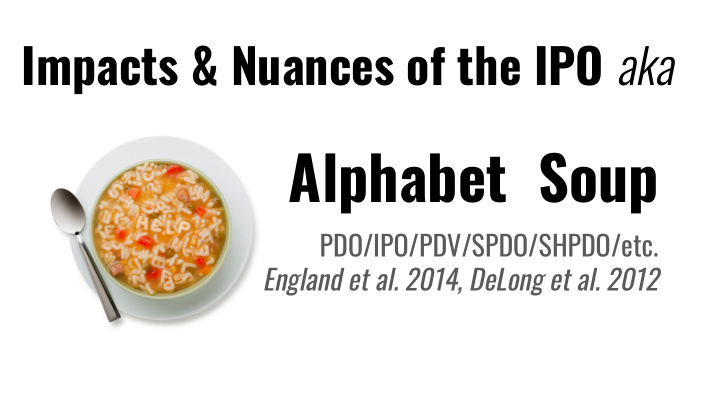



Impacts & Nuances of the IPO aka Alphabet Soup PDO/IPO/PDV/SPDO/SHPDO/etc. England et al. 2014, DeLong et al. 2012
England et al. 2014
Forcing vs. Response Do patterns of increasing CO 2 match those of rising SAT’s?
Hiatuses and pauses and slowdowns...oh, my! Little-to-no warming in global mean temperatures ~1998-2015 Real or Imagined? The fake debate: - Spurious trendlines - Generally begins in 1998 (why?) El Niño raises global T
Hiatuses and pauses and slowdowns...oh, my! The real debate: 1) What caused the slowdown in warming? 2) How common are these hiatuses? kaustubh.info/paleowave
What factors might explain variations in surface air temperature trends? Internal variability Low Insolation Water Vapor & Aerosols Volcanic Activity
How is the global warming “hiatus” defined here? The period since 2001 with little change in global SAT’s Even ignoring the 1997-98 “Super El Niño,” a slowdown in SAT warming is still clear
IPO-Driven Wind Stress Trends
What is the proposed relationship between the IPO, trade winds, and ocean heat uptake?
How does this mechanism account for unusually cold sea surface temperatures in the eastern Pacific? increased W Pacific convergence of near-surface mass/heat→downwelling→stronger equatorial undercurrent→more upwelling in E Pacific→cool E Pacific SST
Why does this study rely on both coupled and ocean-only climate models? Ocean only: prescribe winds (better understood/observed), see how the ocean responds (less well known) Coupled models show atmospheric teleconnections
Increased Ocean Heat Uptake skepticalscience.com, adapted from IPCC AR4
How much of the radiation deficit during the hiatus can be explained by wind-induced cooling? Net ocean heat gain = 1.2 x 10 22 J ~200,000,000
Why do the central and south Pacific show modeled decreases in SST as winds increase, yet ocean heat uptake increases? Shallow Overturning Cells Drijfhout et al. 2005
Why do the central and south Pacific show modeled decreases in SST as winds increase, yet ocean heat uptake increases? Shallow Overturning Cells England et al. Supp. Mat.
If/when the IPO switches back into a positive phase, what might happen to surface air temperatures? Accelerated warming But slowly: 5 yrs for detectable trends Paleoclimate records reflect this, capturing changes in winds associated with accelerated/decelerated warming Thompson et al. 2015
Updated for 2018: Global SATA IPO 20-yr wind stress trends
Proxy Record of PDV?
Newman et al. 2016
W Pacific Coral & E Pacific Geoducks Felis et al. 2010
DeLong et al. 2012
Southern (Hemisphere) Pacific Decadal Oscillation The S Pacific version of the PDO (southern limb of the IPO) 1st EOF of SST variability in South Pacific Shakun & Shaman 2009
Why are paleoclimate proxies useful for low-frequency climate variability, especially in the S Pacific?
Why are paleoclimate proxies useful for low-frequency climate variability, especially in the S Pacific? PAGES 2K 2017
What proxy is used, and what climate variables does it measure in corals? What might be the advantages/limitations of this proxy? Sr/Ca Sr: well-mixed (1000yr), long residence time in ocean (3 my)→generally homogenous in oceans Sr substitutes for Ca in coral skeleton: ratio depends on T (+ vital effects) Beck et al. 1992; Edmond et al. 1992
What proxy is used, and what climate variables does it measure in corals? What might be the advantages/limitations of this proxy? Sr/Ca Advantage: SST proxy, independent of SSS Limitations: Calibrations vary between sites & corals Marshall & McCulloch 2002
How do SST’s at New Caledonia relate to the IPO/PDO? Similar spatial pattern to PDO/IPO (negative phase)
Why might correlations between SST at New Caledonia and the E equatorial Pacific be unusually low? Instrumental SST Coral SST In reconstructed SSTA, it’s not! Interpolation in SST datasets could remove teleconnections with E Pacific
Are spatial correlations with precipitation stronger/weaker than those with SST? Why? Weaker: lower signal:noise ratio
What do the red triangles represent, and why do they often correspond with anomalously cold SST’s? SO 2 lowers global temperatures temporarily Visible in wavelet spectra: “false oscillations”
How do DeLong et al. conclude that this proxy record accurately reconstructs the SHPDO/SPDO? 16 years
What do DeLong et al. conclude about changes in decadal/interdecadal variability during the industrial period (1850-present)? What evidence do they use to support their conclusion? Do you agree with this conclusion? “...decadal scale SST variations modulate in periodicity suggesting a temporal shift in natural decadal variability for this location, which coincides with the beginning of the anthropogenic-warming trend.”
Recommend
More recommend